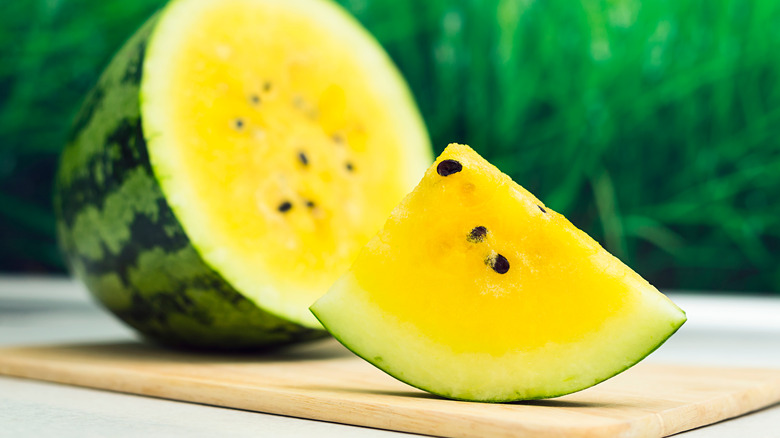The Unexpectedly Massive Amount Of Watermelon Varieties
Watermelons are an iconic summer food, but these sweet, refreshing fruits have a surprisingly rich history. With thousands of years of cultivation across the globe, humans have had plenty of time to breed watermelons into different varieties. Even so, it may be a surprise to learn the sheer number of types grown today.
Watermelons originated in Africa and have been selectively bred by humans for over 4,000 years (via International Tropical Fruits Network) – so long that, until recently, botanists didn't know which plant modern watermelons developed from. As Smithsonian Magazine reports, it turns out that their genetic ancestor is likely the Kordofan melon, native to Sudan.
The International Tropical Fruits Network states that in Northeastern Africa's dry, arid climate, watermelons were useful for their ability to hold water. Ancient Egyptians depicted watermelons in hieroglyphics and buried their pharaohs with watermelon seeds. By the 10th Century, the fruit had spread to Asia and later to Europe and the Americas. Today, China is the world's largest producer of watermelon, but the fruit is also widely grown in Russia, Turkey, Iran, and the United States.
Watermelons come in a surprisingly wide range of varieties
According to the International Tropical Fruits Network, there are over 1,200 varieties of watermelon. The most popular kinds are known for their green rind and red flesh, but watermelons come in an array of sizes, colors, and flavors. The Yellow Crimson watermelon, for example, has yellow flesh and tastes like honey, while Moon and Stars watermelons have a distinct spotted pattern of small yellow "stars" surrounding a large circular "moon."
The popularity of specific varieties varies by country and region. In Japan, specially grown square watermelons sell for up to $200. Square watermelons aren't the only ones that fetch a high price. As per the Los Angeles Times, a Densuke Watermelon, a variety known for its black rind and grown exclusively in Hokkaido, Japan, sold at auction for $6,300.
In the United States, most watermelons grown commercially are strains of the Charleston Gray. According to the USDA, this melon can be grown in a variety of climates and is sturdy and resistant to disease, which makes it easy to ship. While Americans typically consume these watermelons fresh, they can also be turned into cocktails, jellies, and pickled watermelon rind.
Even if you're a die-hard watermelon fan, it's likely that you've never branched out from the varieties found at your local grocery store. It might be worthwhile to seek out a new variety this summer – or even try your hand at growing one of your own.

